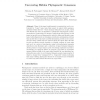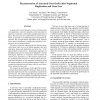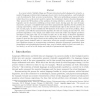20 search results - page 3 / 4 » A Heuristic for Phylogenetic Reconstruction Using Transposit... |
TCBB
2008
14 years 11 months ago
2008
Reconstruction of phylogenetic trees is a fundamental problem in computational biology. While excellent heuristic methods are available for many variants of this problem, new adva...
GECCO
2006
Springer
15 years 3 months ago
2006
Springer
The most popular approaches for reconstructing phylogenetic trees attempt to solve NP-hard optimization criteria such as maximum parsimony (MP). Currently, the bestperforming heur...
111
click to vote
ISBRA
2010
Springer
15 years 6 months ago
2010
Springer
Abstract. Many of the steps in phylogenetic reconstruction can be confounded by “rogue” taxa, taxa that cannot be placed with assurance anywhere within the tree—whose locatio...
108
click to vote
CSB
2003
IEEE
15 years 4 months ago
2003
IEEE
As gene order evolves through a variety of chromosomal rearrangements, conserved segments provide important insight into evolutionary relationships and functional roles of genes. ...
COCOON
2006
Springer
15 years 3 months ago
2006
Springer
In a recent article, Nakhleh, Ringe and Warnow introduced perfect phylogenetic networks--a model of language evolution where languages do not evolve via clean speciation--and form...



